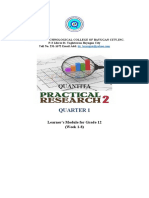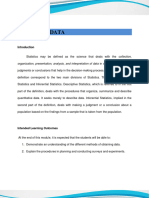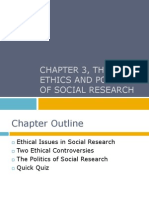0 ratings0% found this document useful (0 votes)
77 viewsQuantitative and Qualitative As Research Based Design
Quantitative and Qualitative As Research Based Design
Uploaded by
Random KidThis document discusses quantitative and qualitative research methods. Quantitative research uses numerical data and statistics to objectively test relationships and examine cause-and-effect. The researcher aims to remain detached. Common tools include questionnaires, surveys, and statistical analysis of pre-existing data. Qualitative research explores experiences through methods like interviews, observations and case studies to understand phenomena from the participant's perspective. It focuses on depth over breadth. Both approaches are valid forms of academic inquiry.
Copyright:
© All Rights Reserved
Available Formats
Download as PPTX, PDF, TXT or read online from Scribd
Quantitative and Qualitative As Research Based Design
Quantitative and Qualitative As Research Based Design
Uploaded by
Random Kid0 ratings0% found this document useful (0 votes)
77 views18 pagesThis document discusses quantitative and qualitative research methods. Quantitative research uses numerical data and statistics to objectively test relationships and examine cause-and-effect. The researcher aims to remain detached. Common tools include questionnaires, surveys, and statistical analysis of pre-existing data. Qualitative research explores experiences through methods like interviews, observations and case studies to understand phenomena from the participant's perspective. It focuses on depth over breadth. Both approaches are valid forms of academic inquiry.
Original Description:
Research 2
Original Title
Research 2
Copyright
© © All Rights Reserved
Available Formats
PPTX, PDF, TXT or read online from Scribd
Share this document
Did you find this document useful?
Is this content inappropriate?
This document discusses quantitative and qualitative research methods. Quantitative research uses numerical data and statistics to objectively test relationships and examine cause-and-effect. The researcher aims to remain detached. Common tools include questionnaires, surveys, and statistical analysis of pre-existing data. Qualitative research explores experiences through methods like interviews, observations and case studies to understand phenomena from the participant's perspective. It focuses on depth over breadth. Both approaches are valid forms of academic inquiry.
Copyright:
© All Rights Reserved
Available Formats
Download as PPTX, PDF, TXT or read online from Scribd
Download as pptx, pdf, or txt
0 ratings0% found this document useful (0 votes)
77 views18 pagesQuantitative and Qualitative As Research Based Design
Quantitative and Qualitative As Research Based Design
Uploaded by
Random KidThis document discusses quantitative and qualitative research methods. Quantitative research uses numerical data and statistics to objectively test relationships and examine cause-and-effect. The researcher aims to remain detached. Common tools include questionnaires, surveys, and statistical analysis of pre-existing data. Qualitative research explores experiences through methods like interviews, observations and case studies to understand phenomena from the participant's perspective. It focuses on depth over breadth. Both approaches are valid forms of academic inquiry.
Copyright:
© All Rights Reserved
Available Formats
Download as PPTX, PDF, TXT or read online from Scribd
Download as pptx, pdf, or txt
You are on page 1of 18
Quantitative and Qualitative as
Research Based Design
Quantitative research is:
a formal, objective, systematic process for
obtaining quantifiable information about the
world;
presented in numerical form, and analysed
through the use of statistics;
used to describe and to test relationships;
used to examine the cause-and-effect of
relationships.
There is one other thing that we need to think
about when designing our quantitative research
study, and that is the role of the researcher.
Quantitative researchers attempt to remain
detached from the study, and from the sample (in
studies where the sample is made up of human
beings). They strive to maintain objectivity - in
other words they try to not influence it with their
own personal values, feelings, and experiences.
Quantitative methods emphasize objective
measurements and the statistical, mathematical,
or numerical analysis of data collected through
polls, questionnaires, and surveys, or by
manipulating pre-existing statistical data
using computational techniques. Quantitative
research focuses on gathering numerical data and
generalizing it across groups of people or to
explain a particular phenomenon.
The introduction to a quantitative study is usually
written in the present tense and from the third
person point of view. It covers the following
information:
Identifies the research problem -- as with any
academic study, you must state clearly and
concisely the research problem being
investigated.
Reviews the literature -- review scholarship on
the topic, synthesizing key themes and, if
necessary, noting studies that have used similar
methods of inquiry and analysis. Note where key
gaps exist and how your study helps to fill these
gaps or clarifies existing knowledge.
Study population and sampling -- where did the
data come from; how robust is it; note where
gaps exist or what was excluded. Note the
procedures used for their selection;
Data collection – describe the tools and methods
used to collect information and identify the
variables being measured; describe the methods
used to obtain the data; and, note if the data was
pre-existing [i.e., government data] or you
gathered it yourself. If you gathered it yourself,
describe what type of instrument you used and
why.
Note that no data set is perfect--describe any
limitations in methods of gathering data.
Data analysis -- describe the procedures for
processing and analyzing the data. If appropriate,
describe the specific instruments of analysis used to
study each research objective, including mathematical
techniques and the type of computer software used to
manipulate the data.
Results
The finding of your study should be written
objectively and in a succinct and precise format. In
quantitative studies, it is common to use graphs,
tables, charts, and other non-textual elements to help
the reader understand the data.
Statistical analysis -- how did you analyze the
data? What were the key findings from the data?
The findings should be present in a logical,
sequential order.
Instrument used in Quantitative Research
Face -to -face interviews have a distinct advantage
of enabling the researcher to establish rapport with
potential participants and therefor gain their
cooperation. These interviews yield highest
response rates in survey research. They also allow
the researcher to clarify ambiguous answers and
when appropriate, seek follow-up information.
Disadvantages include impractical when large
samples are involved time consuming and
expensive.(Leedy and Ormrod, 2001)
Questionnaires
Paper-pencil-questionnaires can be sent to a large
number of people and saves the researcher time
and money. People are more truthful while
responding to the questionnaires regarding
controversial issues in particular due to the fact
that their responses are anonymous. But they also
have drawbacks. Majority of the people who
receive questionnaires don't return them and
those who do might not be representative of the
originally selected sample.(Leedy and Ormrod,
2001)
Qualitative
a systematic subjective approach used to describe
life experiences and give them meaning
To gain insight; explore the depth, richness, and
complexity inherent in the phenomenon.
Phenomenology
Purpose, goal - to describe experiences as they are
lived
examines uniqueness of individual's lived situations
each person has own reality; reality is subjective
Research question development
What does existence of feeling or experience
indicate concerning the phenomenon to be
explored
What are necessary & sufficient constituents of
feeling or experience?
What is the nature of the human being?
Method
No clearly defined steps to avoid limiting
creativity of researcher
Sampling & data collection
Seek persons who understand study & are willing
to express inner feelings & experiences
Describe experiences of phenomenon
Write experiences of phenomenon
Direct observation
Audio or videotape
Data analysis
Classify & rank data
Sense of wholeness
Examine experiences beyond human awareness/ or
cannot be communicated
Outcomes
Findings described from subject's point-of-view
Researcher identifies themes
Structural explanation of findings is developed
Case study
Purpose - describe in-depth the experience of one
person, family, group, community, or institution
Method
Direct observation and interaction with subject
Outcomes - in-depth description of the experience
Analysis - synthesis of experience
Data Collection
Interview with audiotape & videotape
Direct, non-participant observation
Participant observation
Field notes, journals, logs
Data Collection is an important aspect of any
type of research study. Inaccurate data collection
can impact the results of a study and ultimately
lead to invalid results.
You might also like
- Research Methods: Simple, Short, And Straightforward Way Of Learning Methods Of ResearchFrom EverandResearch Methods: Simple, Short, And Straightforward Way Of Learning Methods Of ResearchRating: 4 out of 5 stars4/5 (13)
- Mirror ShadesDocument180 pagesMirror ShadesThiago Zanotti67% (3)
- Bracing Supplement Document: GIB Bracing Design NotesDocument22 pagesBracing Supplement Document: GIB Bracing Design NotesJimuel MejicaNo ratings yet
- Reviewer in PR2Document4 pagesReviewer in PR2Farell BanuelosNo ratings yet
- Lecture 01 Overal Introduction 311Document4 pagesLecture 01 Overal Introduction 311Zovuyo MthanyanaNo ratings yet
- Research and Its Importance in Our Daily LifeDocument27 pagesResearch and Its Importance in Our Daily LifeSheila Mae LiraNo ratings yet
- Criminological Research 1Document50 pagesCriminological Research 1Juaton, Aaron JornelNo ratings yet
- Unit 5 SociologyDocument2 pagesUnit 5 SociologyMukul KumarNo ratings yet
- How The Way To Collect Quantitative and Qualitative ResearchDocument5 pagesHow The Way To Collect Quantitative and Qualitative Researchdanu saputroNo ratings yet
- Method of Collecting DataDocument6 pagesMethod of Collecting DatazeliaNo ratings yet
- Week11 PDFDocument5 pagesWeek11 PDFJude BautistaNo ratings yet
- Difference Between Qualitative and Quantitative Literature ReviewDocument4 pagesDifference Between Qualitative and Quantitative Literature ReviewaflshvifmNo ratings yet
- Chapter 2 - Materials and MethodsDocument6 pagesChapter 2 - Materials and MethodsQUIZON, Ron Charles D.No ratings yet
- Reflection 9-Communicating The Research Results: Research Presentation Abulencia, Jessa Mae PDocument6 pagesReflection 9-Communicating The Research Results: Research Presentation Abulencia, Jessa Mae PJESSA MAE ABULENCIANo ratings yet
- App 005: Practical Research 1Document10 pagesApp 005: Practical Research 1ayannazxiNo ratings yet
- Research DesignDocument28 pagesResearch DesignAnonymous Z3994mNo ratings yet
- Researchmethodology Qu AnsDocument14 pagesResearchmethodology Qu Ansjonideap91No ratings yet
- 3.PART ONE Qualitative Design SamplingDocument21 pages3.PART ONE Qualitative Design Samplingabdulhadiawang00000No ratings yet
- ResearchDocument29 pagesResearchRachel Tannagan BaylosisNo ratings yet
- Business ResearchDocument29 pagesBusiness ResearchrameNo ratings yet
- ALICEDocument6 pagesALICESOMOSCONo ratings yet
- RM Cia 1 1620203Document12 pagesRM Cia 1 1620203Aditya JainNo ratings yet
- Understanding Ways To Collect DataDocument15 pagesUnderstanding Ways To Collect DataIrene LumiganNo ratings yet
- Qualitative Research: Instructor: Ms. Armie U. Landrito I.E.T.I College AlabangDocument46 pagesQualitative Research: Instructor: Ms. Armie U. Landrito I.E.T.I College AlabangArmie LandritoNo ratings yet
- Unit 2-Lrw2014-Types of ResearchDocument22 pagesUnit 2-Lrw2014-Types of ResearchHanani HlomaniNo ratings yet
- Module For P.R 2Document17 pagesModule For P.R 2Ryan SaladagaNo ratings yet
- PR2 2ndDocument28 pagesPR2 2ndjasmine fayNo ratings yet
- Chapter 2 Methodology - 20240615 - 204029 - 0000Document43 pagesChapter 2 Methodology - 20240615 - 204029 - 0000deprajohn1202No ratings yet
- Data Collection Sem OldDocument62 pagesData Collection Sem OldAmy Lalringhluani ChhakchhuakNo ratings yet
- Quantitative vs. Qualitative Main Methods Used in Empirical ResearchDocument17 pagesQuantitative vs. Qualitative Main Methods Used in Empirical ResearchJohnson PadiyaraNo ratings yet
- Social Research 05032023 113509pmDocument12 pagesSocial Research 05032023 113509pmGhayyur MehdiNo ratings yet
- PR2 Week 1Document6 pagesPR2 Week 1Argie MabagNo ratings yet
- Analyzing Qualitative DataDocument60 pagesAnalyzing Qualitative DataAshira Jonsine De GuzmanNo ratings yet
- ResearchDocument19 pagesResearchmumaid258No ratings yet
- EDA-Chapter-1 Batangas State UniversityDocument27 pagesEDA-Chapter-1 Batangas State Universitygerjoiroldan10No ratings yet
- Research QualitativeDocument5 pagesResearch QualitativepauloromanfernandodelvalleNo ratings yet
- Qualitative & Quantitative ResearchDocument42 pagesQualitative & Quantitative ResearchAllenaNo ratings yet
- PR1 - Handouts 5Document5 pagesPR1 - Handouts 5Donald EspirituNo ratings yet
- Types of ResearchDocument6 pagesTypes of ResearchLanieGraceSandhuNo ratings yet
- ResearchDocument29 pagesResearchCharise Daitol LacnoNo ratings yet
- 8 Types of Qualitative ResearchDocument3 pages8 Types of Qualitative ResearchhinaNo ratings yet
- Business Research MethodologyDocument13 pagesBusiness Research MethodologyAakash RastogiNo ratings yet
- Admire S Mabhena Research Methods Ass 1Document3 pagesAdmire S Mabhena Research Methods Ass 1admire simbarashe MabhenaNo ratings yet
- Research MethodologyDocument58 pagesResearch Methodologytripathi_indramani5185No ratings yet
- Characteristics of Quantitative and QualitativeResearchDocument2 pagesCharacteristics of Quantitative and QualitativeResearchlekz re71% (7)
- ResearchDocument12 pagesResearchBrian-krisen Pagulayan-NaragNo ratings yet
- DATA COLLECTION METHODS Communication StudiesDocument4 pagesDATA COLLECTION METHODS Communication StudiesjaylamarieNo ratings yet
- Module 1 Nature of Inquiry and ResearchDocument41 pagesModule 1 Nature of Inquiry and ResearchJerome Maleon de Jesus96% (27)
- Engineering Data Analysis Chapter 1 - Obtaining DataDocument10 pagesEngineering Data Analysis Chapter 1 - Obtaining Dataetdr4444No ratings yet
- Research Method Course PPT (3rd Years LaSu Students) 2012Document100 pagesResearch Method Course PPT (3rd Years LaSu Students) 2012Melkamu AmusheNo ratings yet
- LESSONDocument3 pagesLESSONeizamaerachelgundanNo ratings yet
- Chapter 1 Nature and Purpose of ResearchDocument46 pagesChapter 1 Nature and Purpose of ResearchAiza San Pedro Santos100% (1)
- Practical Research Lesson 2Document25 pagesPractical Research Lesson 2Lance Go LlanesNo ratings yet
- Research Method: Survey Research Is Defined As "The Collection of Information From A Sample of IndividualsDocument2 pagesResearch Method: Survey Research Is Defined As "The Collection of Information From A Sample of IndividualsJohndrew MontevillaNo ratings yet
- Discussion PaperDocument8 pagesDiscussion PaperJonamae OcanNo ratings yet
- Week 6 NotesDocument6 pagesWeek 6 NotesDr. Cherise TurnerNo ratings yet
- 06 Critical Appraisal of Qualitative Research 2Document27 pages06 Critical Appraisal of Qualitative Research 2Nayomi YviNo ratings yet
- Pure (To Develop Theory and Expand Knowledge Base) and Applied (To Develop Solutions For Problems and Relevant Application For CriminologicalDocument7 pagesPure (To Develop Theory and Expand Knowledge Base) and Applied (To Develop Solutions For Problems and Relevant Application For CriminologicalGivehart Mira BanlasanNo ratings yet
- Participatory Action Research for Evidence-driven Community DevelopmentFrom EverandParticipatory Action Research for Evidence-driven Community DevelopmentNo ratings yet
- Research Methods and Methods in Context Revision Notes for AS Level and A Level Sociology, AQA FocusFrom EverandResearch Methods and Methods in Context Revision Notes for AS Level and A Level Sociology, AQA FocusNo ratings yet
- 113 RMC 11-2024 V3Document8 pages113 RMC 11-2024 V3Random KidNo ratings yet
- Antipolo's Best: Marketing PlanDocument33 pagesAntipolo's Best: Marketing PlanRandom KidNo ratings yet
- Health-Enhancing Physical ActivityDocument10 pagesHealth-Enhancing Physical ActivityRandom KidNo ratings yet
- Law 32Document2 pagesLaw 32Random KidNo ratings yet
- Law 33Document2 pagesLaw 33Random KidNo ratings yet
- A Century of Cooperativism in The PhilippinesDocument20 pagesA Century of Cooperativism in The PhilippinesRandom KidNo ratings yet
- Law 15Document2 pagesLaw 15Random KidNo ratings yet
- Law 18Document2 pagesLaw 18Random KidNo ratings yet
- Law 19Document2 pagesLaw 19Random KidNo ratings yet
- Law 3Document2 pagesLaw 3Random KidNo ratings yet
- Araling Panlipunan: Takdang AralinDocument3 pagesAraling Panlipunan: Takdang AralinRandom KidNo ratings yet
- Early Life: William Shakespeare Was Baptized OnDocument11 pagesEarly Life: William Shakespeare Was Baptized OnRandom KidNo ratings yet
- Project in APDocument18 pagesProject in APRandom KidNo ratings yet
- PDFDocument1 pagePDFRandom KidNo ratings yet
- How Beneficial To The Body Do Getting Enough Rest and Sleep Is?Document1 pageHow Beneficial To The Body Do Getting Enough Rest and Sleep Is?Random KidNo ratings yet
- Exercise 2Document2 pagesExercise 2Random KidNo ratings yet
- Billie Eilish: Ocean EyesDocument2 pagesBillie Eilish: Ocean EyesRandom KidNo ratings yet
- MealDocument2 pagesMealRandom KidNo ratings yet
- Jtagjet-C2000: Emulator For The C2000 Family of Mcu/Dsps From Texas InstrumentsDocument3 pagesJtagjet-C2000: Emulator For The C2000 Family of Mcu/Dsps From Texas Instrumentsreza yousefiNo ratings yet
- AnyWeb - Trends 2024 - Which Technology Will Most Revolutionize Our FutureDocument16 pagesAnyWeb - Trends 2024 - Which Technology Will Most Revolutionize Our Futurebp6tjgxs4jNo ratings yet
- Yealink - SIP-T21P-E2 - Datasheet - by LATNOK CDDocument2 pagesYealink - SIP-T21P-E2 - Datasheet - by LATNOK CDCoko Mirindi MusazaNo ratings yet
- 1 s2.0 S1815385213000266 Main PDFDocument5 pages1 s2.0 S1815385213000266 Main PDFP NielsenNo ratings yet
- TERM PAPER - DBMS NDocument5 pagesTERM PAPER - DBMS NMD ShohagNo ratings yet
- NEG3MathPTPaper 12 06 10Document6 pagesNEG3MathPTPaper 12 06 10Mary Lou m. VelezNo ratings yet
- The Dance of Condong Legong Keraton in Yogyakarta: Transfer The Character Education To ChildrenDocument7 pagesThe Dance of Condong Legong Keraton in Yogyakarta: Transfer The Character Education To ChildrenNi Luh Enita MaharaniNo ratings yet
- Monetary PolicyDocument13 pagesMonetary PolicyAppan Kandala VasudevacharyNo ratings yet
- Solidarity and EndosulfanDocument22 pagesSolidarity and EndosulfanbaskanjirNo ratings yet
- Research On Airport Security Based On Virtual Queuing TheoryDocument5 pagesResearch On Airport Security Based On Virtual Queuing TheorySunil SagarNo ratings yet
- 7.modeling BaseflowDocument4 pages7.modeling Baseflowsugendengal100% (1)
- Capstone Sop 19 20Document14 pagesCapstone Sop 19 20Anand Kumar SinghNo ratings yet
- Intro To Phili of Human Person Week1Document33 pagesIntro To Phili of Human Person Week1edson vicenteNo ratings yet
- Experiment 3Document4 pagesExperiment 3Kim Joy CoronelNo ratings yet
- Diploma Advert 2021 For WebsiteDocument4 pagesDiploma Advert 2021 For WebsiteTukahebwa CliffNo ratings yet
- Essay On FlexibilityDocument6 pagesEssay On FlexibilityJohn DoeNo ratings yet
- Ficha Tecnica Cacao PolvoDocument2 pagesFicha Tecnica Cacao PolvofernandagbNo ratings yet
- DTE MicroprojectDocument22 pagesDTE MicroprojectShreyas Bagate100% (1)
- Animal Behavior An Evolutionary Approach John Alcock Download PDFDocument64 pagesAnimal Behavior An Evolutionary Approach John Alcock Download PDFaduchheed100% (2)
- The Launch of The EuroDocument13 pagesThe Launch of The Euromai.hnx4205No ratings yet
- Wipsy MenuDocument14 pagesWipsy MenuBergas WibowoNo ratings yet
- PreviewDocument91 pagesPreviewStoie GabrielNo ratings yet
- MatrixDocument15 pagesMatrixLAWAND MUSLEMNo ratings yet
- XN-L - Reference Interval From General Information 2017Document4 pagesXN-L - Reference Interval From General Information 2017widiawaty100% (1)
- A Guide To Tactical Appreciation 1987Document112 pagesA Guide To Tactical Appreciation 1987Andrea DiazNo ratings yet
- Principles of Interior Design-20 Jan-11Document9 pagesPrinciples of Interior Design-20 Jan-11Sandip Ghadge100% (1)
- Babbie Ethics 5e PPT CH 3Document31 pagesBabbie Ethics 5e PPT CH 3tudorbianca7267No ratings yet
- New Composite 2024Document38 pagesNew Composite 2024pushpender bajajNo ratings yet











































































































